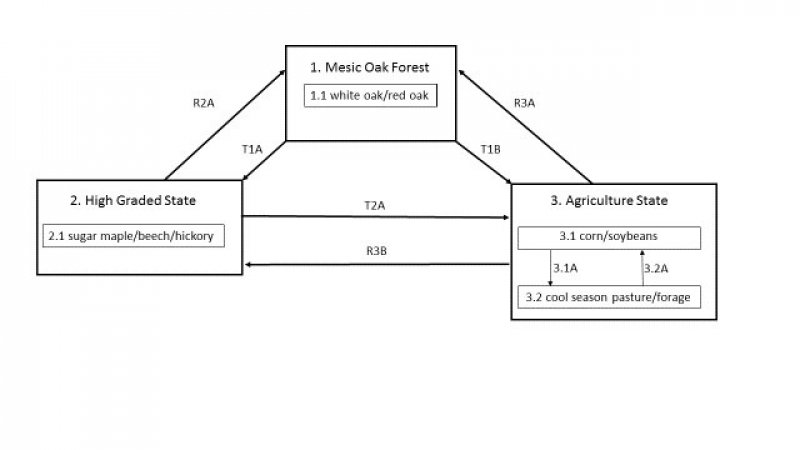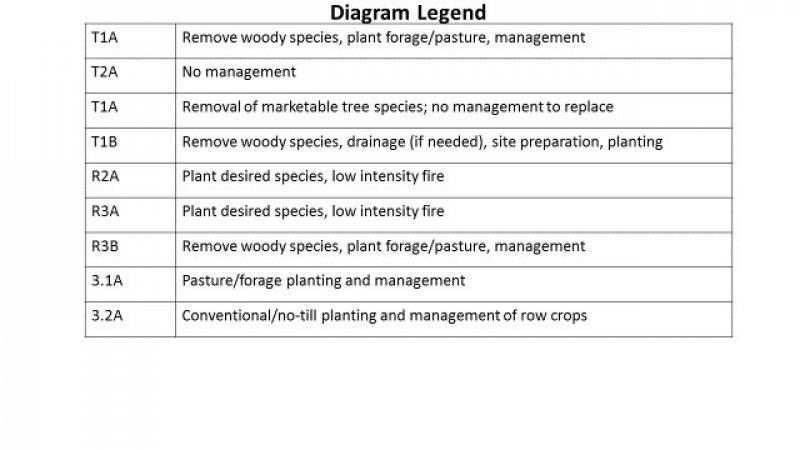
Natural Resources
Conservation Service
Ecological site F111XB303IN
Dry Bedrock Forest
Last updated: 9/11/2024
Accessed: 04/29/2025
General information
Provisional. A provisional ecological site description has undergone quality control and quality assurance review. It contains a working state and transition model and enough information to identify the ecological site.
MLRA notes
Major Land Resource Area (MLRA): 111X–Indiana and Ohio Till Plain
111B – Indiana and Ohio Till Plain, Northeastern Part. This area is in the Eastern Lake and Till Plains Sections of the Central Lowland Province of the Interior Plains. The entire MLRA is glaciated, and most areas are dominated by ground moraines that are broken in places by lake plains, outwash plains, flood plains, and many recessional moraines. The ground moraines and lake plains in front of the recessional moraines are flat to undulating. In many places stream valleys occur at the leading edge of the recessional moraines. Narrow, shallow valleys commonly are along the major rivers and streams in this MLRA, and some areas along the major rivers and streams have deposits of sand. Elevation ranges from 630 to 1,550 feet (190 to 470 meters), increasing gradually from west to east. Relief is mainly a few meters, but in some areas hills rise as much as 100 feet (30 meters) above the adjoining plains.
The extent of the major Hydrologic Unit Areas (identified by four-digit numbers) that make up this MLRA is as follows: Western Lake Erie (0410), 41 percent; Wabash (0512), 28 percent; Scioto (0, 28 percent; Scioto (0506), 10 percent; St. Clair-Detroit (0409), 9 percent; Great Miami (0508), 6 percent; Southeastern Lake Michigan (0405), 5 percent; and Southwestern Lake Huron (0408), 1 percent. The Huron River in Michigan, Cedar Creek in Indiana, and the Sandusky River in Ohio have been designated as National Wild and Scenic Rivers in this MLRA.
The surficial materials in this area include glacial deposits of till, outwash, and lacustrine sediments from Wisconsin and older glacial periods. A thin mantle of loess occurs in some areas. Most of the MLRA is underlain by Silurian and Devonian limestone and dolostone. Middle Devonian to Early Mississippian black shale and Early to Middle Mississippian siltstone and shale are in some areas of the northern part of the MLRA.
Classification relationships
Major Land Resource Area (USDA-Natural Resources Conservation Service, 2006)
USFS Ecological Regions (USDA, 2007):
Sections –Central Till Plains, Beech Maple (222H), South Central Great Lakes (222J)
Subsections – Bluffton Till Plains (222Ha), Bluffton-Ann Arbor Till Plains (222Je), Jackson Interlobate Moraine (222Jg), Steuben Interlobate Moraines (222Ji)
NatureServe Systems anticipated (NatureServe, 2011): Agriculture - Cultivated Crops and Irrigated Agriculture, Agriculture – Pasture/Hay, North-Central Interior Beech-Maple Forest, North-Central Interior Dry-Mesic Oak Forest and Woodland
LANDFIRE Biophysical Settings anticipated (USGS, 2010): North-Central Interior Beech-Maple Forest, North-Central Interior Dry-Mesic Oak Forest and Woodland
Ecological site concept
Ecological Site Concept
This site is an upland site generally formed on residuum weathered from limestone and shale. The soil surface is light in color (lighter than 3/2 Munsell) and are moderately well drained or drier with slopes generally from up to 70%. This site is generally on steeper slopes and the soil is often shallower to the restrictive layer, with higher drainage than on the commonly adjacent Mesic Bedrock Forest site (F111BY302IN).
This woodland site was, historically, a mesic oak forest site with oaks, both white and red oak, being the dominant canopy species. The combination of moderately deep soils and slope restricted the impact of fire to portions of the site. This allows the site have also have canopy level, shade tolerant species such as sugar maple with the oak species. Overall, the largest driver of species dynamics is that of gap-phase regeneration that contributes to the maintenance of the site as a mixed hardwoods. Selective tree harvest moves the site to a new state where the canopy becomes dominated by less desirable timber species like sugar maple, tulip tree, hickory and ash species. Currently, the areas with less slope have been converted for agricultural use, mostly hay and pasture, but some are being used for small grains as well.
Associated sites
| R111XB301IN |
Dark Bedrock Prairie Soil surface is darker in color. |
|---|---|
| F111XB302IN |
Mesic Bedrock Forest Soils are poorly to SWPD. |
Similar sites
| R111XB402IN |
Dry Outwash Integrade Dry Outwash Integrate |
|---|---|
| F111XB404IN |
Dry Outwash Upland Dry Outwash Upland |
Table 1. Dominant plant species
| Tree |
(1) Quercus alba |
|---|---|
| Shrub |
Not specified |
| Herbaceous |
Not specified |
Click on box and path labels to scroll to the respective text.



